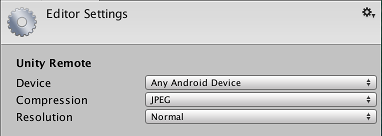Unity Remote 4
Unity Remote (currently at version 4), is a downloadable app designed to help with Android or iOS development. The app connects with Unity while you are running your project in Play mode from the editor. The visual output from the editor is sent to the device’s screen and the live inputs are sent back to the running project in Unity. This allows you to get a good impression of how your game really looks and handles on the target device without the nuisance of a full build for each test.
With version 4, Unity Remote has been completely rewritten and replaces the separate iOS and Android Remote apps used with earlier versions.
Device and Feature Support
Unity Remote currently supports Android devices (on Windows and OSX via a USB connection) and iOS devices (iPhone, iPad and iPod touch, through USB and only on OSX)
The Game view of the running Unity project is duplicated on the device screen but at a reduced framerate. The following input data from the device is also streamed back to the editor:
- Сенсорный ввод
- Акселерометр
- Гироскоп
- Потоки камеры устройства
- Compass
- GPS
Note that the Remote app simply shows the visual output on the device and takes input from it. The game’s actual processing is still done by the Unity editor on the desktop machine and so its performance is not a perfect reflection of the built app.
Obtaining and Using Unity Remote
Unity Remote can be downloaded for free in the form of a Unity project that you build yourself or as a pre-built app from the device’s app store:
- Unity Проект (требует пользовательскую сборку): Asset Store
- Android Приложение: Google Play
- iOS Приложение: App Store
Having downloaded the app, you should install and run it on your device and also connect the device to your computer using a USB cable.
- Зайдите в Edit->Project Settings->Editor и в настройках Unity Remote выберите Any Android Device, а потом обратно Any iOS Device.

If you now click the Play button in the editor, you should see your game appear on the device as well as the Unity game window as Unity connects to the Remote app. While the game plays, input from the device (accelerometer, etc) will be sent to your scripts as if they were running on the device itself.
Решение проблем
I have more than one device plugged in but only one of them works with Unity
В настоящее время Unity Remote не поддерживает несколько подключенных устройств того же рода (т.е. два iPhone’а или два Android’а), и он автоматически выберет первое устройство, которое обнаружит. Но, если иметь одно iOS и одно Android устройство, подключенные одновременно, то это будет работать, и вы сможете выбрать какое устройство использовать в Edit->Project Settings->Editor в настройках Unity Remote, прежде чем нажать кнопку Play.
Я получаю действительно плохое качество графики при запуске своей игры в Unity Remote. Что я могу сделать, чтобы это исправить?
При использовании Unity Remote, игра на самом деле работает в редакторе Unity а его визуальное содержимое передается на целевое устройство. Поскольку пропускная способность между редактором и устройством ограничена, поток сжимается, и вы увидите неизбежные артефакты. Это невозможно изменить. Unity Remote предназначен для быстрой приближенной проверки, как ваша игра будет чувствовать себя при запуске на устройстве и для других быстрых тестов. Для реальной проверки используйте обычные средства для сборки и запуска приложения на устройстве (используйте в редакторе Unity).
In the Unity Remote section of the Editor settings (menu: Edit > Project Settings > Editor), you can switch the compression method between JPEG and PNG and also optionally downsize the resolution of the screen image. PNG compression is “lossless” (ie, image quality doesn’t degrade) but uses more bandwidth than JPEG. A downsized image has lower bandwidth requirements than one at full resolution. By changing these settings, you can trade image accuracy off against framerate as necessary.
However, you should bear in mind that Unity Remote is only really intended to give a quick approximate check of how your game will look and feel when running on the device. You should make sure that you occasionally do a full build and test the “real” app.
Редактор не подключается к устройству iOS. Что я могу сделать?
Чтобы установить соединение с устройством iOS через USB, Unity использует стороннюю утилиту (iproxy), которая иногда ведет себя некорректно, и Unity не может обнаружить это. Вы можете попробовать следующие, чтобы решить эту проблему:
- Переподключите устройство iOS.
- Перезапустите устройство iOS.
- Зайдите в Edit->Project Settings->Editor и в настройках Unity Remote выберите Any Android Device, а потом обратно Any iOS Device.
- Перезапустите редактор Unity.
- Quit the Unity editor, open the Terminal and execute the command
killall unityiproxy. Then, restart the editor again.
В большинстве случаев переподключения или перезапуска устройства iOS достаточно, чтобы решить проблему.